Creating CMYK Prepress PDFs with Inkscape and Scribus
tl;dr Inkscape cannot export prepress PDFs. Scribus can, though. I'll show you how.
Inkscape is a fantastic tool for creating beautiful vector graphics (I have sung its praises in this blog before). Unfortunately, there is one thing that Inkscape cannot do: Export a print-production-ready PDF. The moment you finish designing your awesome new flyer, business card or poster with Inkscape and then realize you cannot simply hit the “send PDF to printing service” button can be somewhat frustrating. But don’t worry, there is a way!
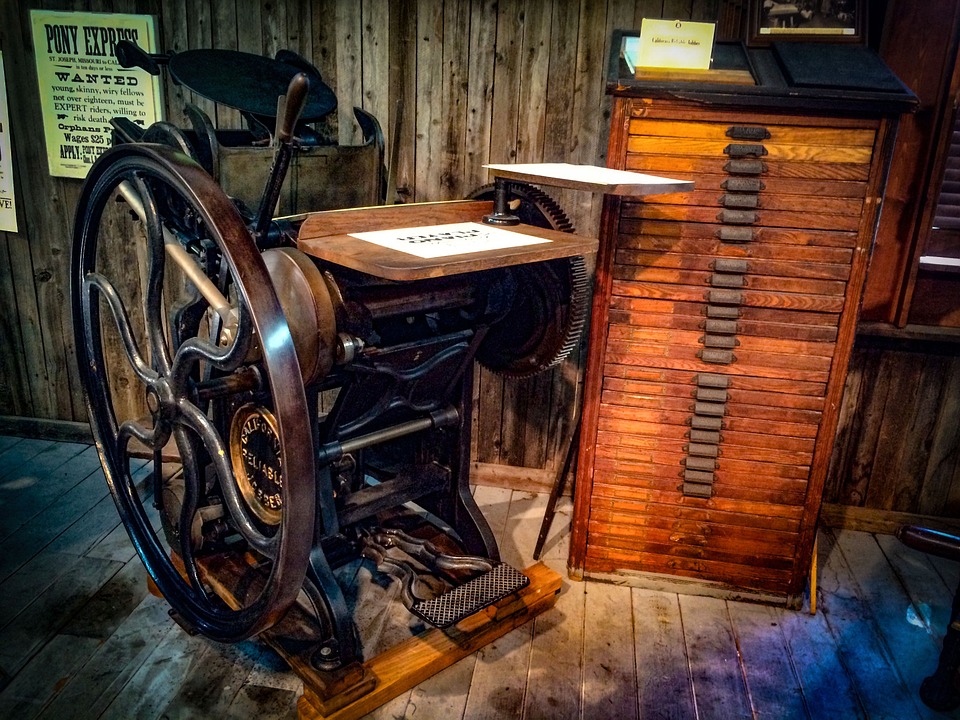 Let’s get it ready for printing.
Let’s get it ready for printing.
There are two main reasons why Inkscape fails in the prepress department: Firstly, while it can export various PDF standards, it does not support the de-facto prepress printing standard PDF/X-3. Secondly, and more importantly, Inkscape is not able to embed color profiles in exported PDFs.
Luckily for us, there is another great free and open-source software called Scribus. Inkscape and Scribus are like two good buddies that help each other out. While Scribus is not as powerful when it comes to creating and editing your graphic illustration, it shines when you want to take that creation to the printing press. In the following, I’ll show you a workflow that I have successfully used to obtain prepress PDFs (with a properly embedded color profile) using the two programs.
A word of warning: The workflow involves converting colors manually, so if you have a lot of colors in your source document, this might be a show stopper and you should look for commercial alternatives.
Step 0: Set up Inkscape, Color Profiles and Scribus
- Install both Inkscape and Scribus.
- Most of the (European) printing companies I have used, require the “ISO Coated v2 300% (ECI)” profile. Make sure
you find out which color profile your printing service requires, then download it
and save it to your system’s default location for color profiles. Some typical locations:
- Windows:
\Windows\System32\Spool\Drivers\Coloror\Windows\System\Color - Mac:
Username/Library/ColorSync/ProfilesorHD/Library/ColorSync/Profiles - They could be stored elsewhere. Google around…
- Windows:
- In Scribus, go to “Settings”, then “Color Management”. Under “CMYK Solid Colors” choose the profile you just installed in the dropdown. If it doesn’t appear, you haven’t saved it in the right location. Repeat the previous step until Scribus can find the color profile.

- If you want, check “Simulate Printer on the Screen” and “Convert all colors to printer space”. Scribus will then attempt to make the colors look more similar to the actual print result, though that simulation might still be off by a lot if your screen is not calibrated.
Step 1: Prepare the SVG
- Open/create your SVG file with Inkscape.
- Convert all your texts to paths (select text objects, press
Shift+Ctrl+Cand ungroup withShift+Ctrl+Gto ensure the characters have become individual vector shapes). - Get rid of any additional layers you might have (merge everything into one layer).
- Get rid of any transparent elements (check the stroke and fill of all objects).
- “Save a copy…” of the SVG in a separate file (like
myfile_final.svg).
Step 2: Convert the Colors
- Open the SVG you just created with Scribus (in the “Open” dialog change the filter to “All files” to be able to pick your SVG). Scribus may complain that some features of your SVG are not supported (which is most likely because of Inkscape data in the SVG or because you still have transparencies defined somewhere). Don’t worry about it for now.
- Under “File” > “Document Setup” > “Page Size” double-check that the width and height are correct (I’m a bit pedantic and find that they’re usually off by sub-millimeters). Correct the size if necessary.
- Go to “Edit” > “Colors”. You should see numerous colors imported from the SVG.
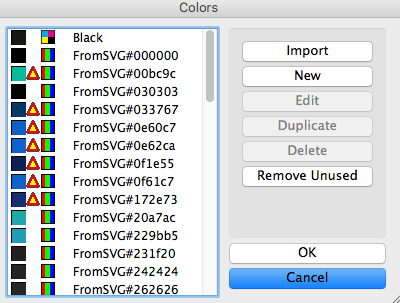
- Click on “Remove Unused”. This cleans the palette and leaves only the colors that are actually in use.
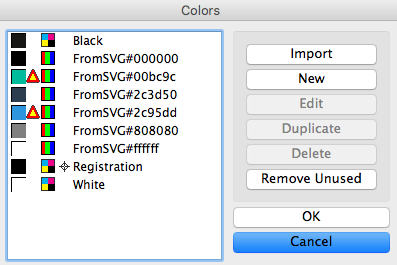
- If you’re using a pure black (#000000) or pure white (#ffffff) in your SVG, choose it, then click on “Delete” and “Replace with” the predefined CMYK black and white.
- Go through each of the remaining colors that still appear as RGB (
 ),
click on “Edit”, give them a meaningful name and choose “CMYK” for the color model. If you have an idea which CMYK
values the color should have (e.g. from a color book) adjust the values, otherwise just accept the autoconverted values.
),
click on “Edit”, give them a meaningful name and choose “CMYK” for the color model. If you have an idea which CMYK
values the color should have (e.g. from a color book) adjust the values, otherwise just accept the autoconverted values. - When you’re done, the color dialog should only contain CMYK (
 ) colors.
) colors.
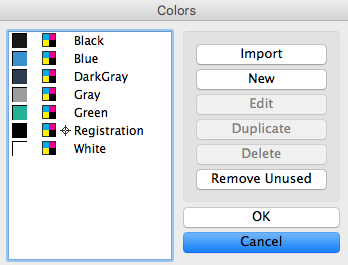
- Save your Scribus file as
myfile_final.sla.
Step 3: Export the Final PDF
- In Scribus, go to “File” > “Export” > “Save as PDF…”
- Choose a filename like
myfile_cmyk_final.pdf, preferably in a subfolder namedprepress(so that it’s crystal clear which are the final files that should be sent to printing). - As mentioned above, most printing services require PDF/X-3 files, so choose that in the “Compatibility” dropdown.

- I also usually untick “Compress Text and Vector Graphics” in the same dialog, though that’s probably unnecessary (there shouldn’t be any text left in your file). I’m just a bit superstitious.
- Go to the “Pre-press” tab and under “Output Profile” choose your desired color profile in the dropdown:
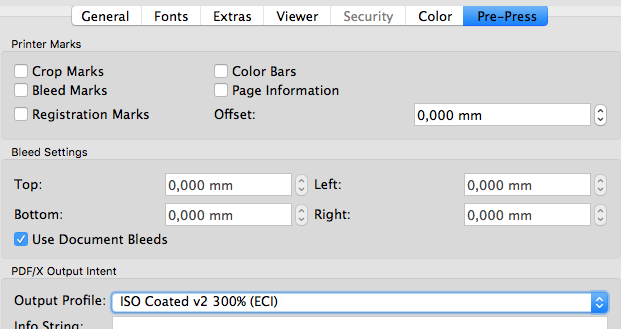
- Hit “Save”.
That’s it. Enjoy your production-ready PDF file ;-)!

